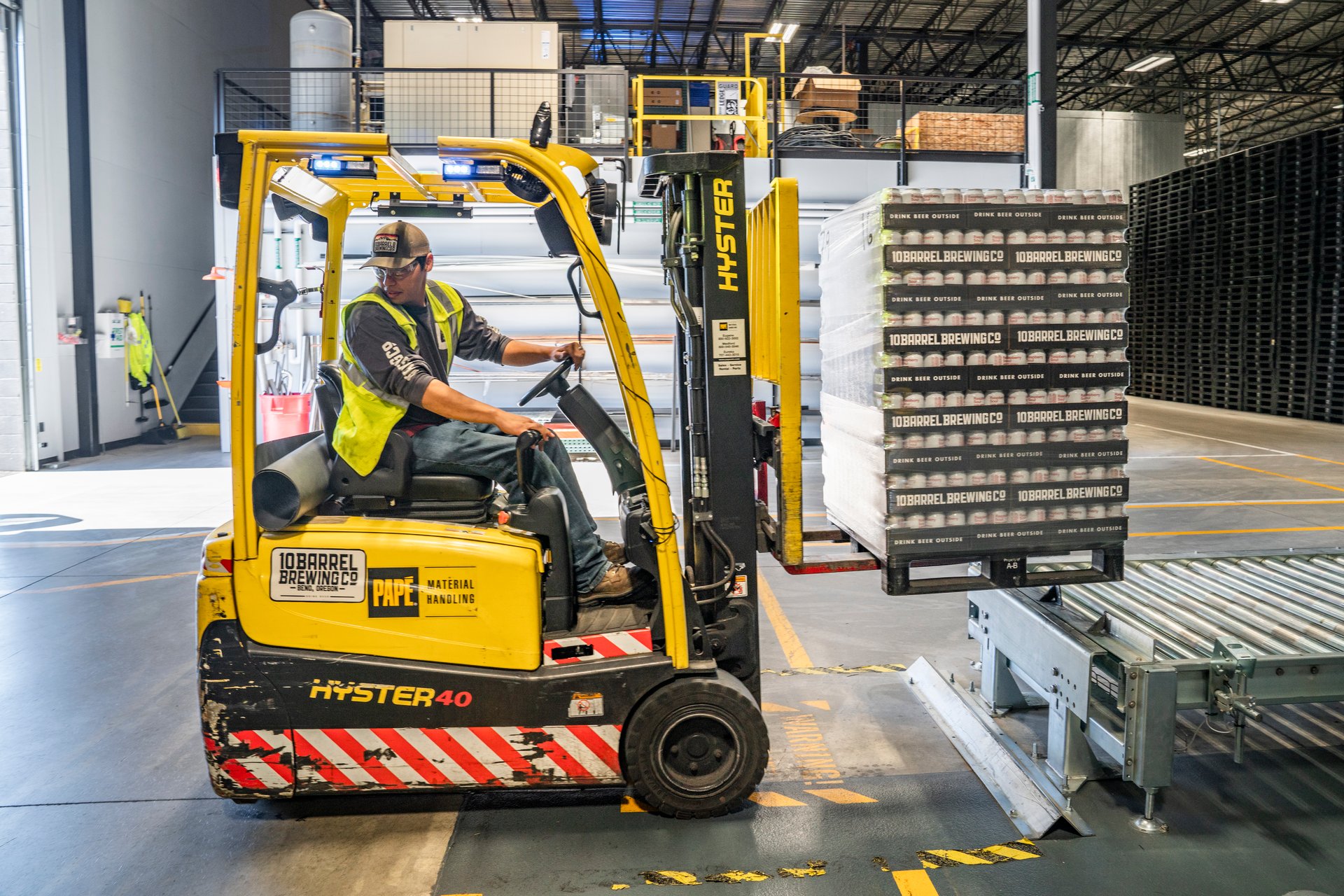3PL Warehouse
Delving Deeper into the Role and Advantages of 3PL Warehouses in Modern Logistics
E-commerce and retail leaders increasingly lean on 3PL firms to optimize their operational flow and amp up customer satisfaction. By offloading logistics, including storage and distribution tasks, they're in a prime position to focus on their bread and butter: innovating products, strategizing marketing, and enhancing customer relations.
3PL warehouse companies offer a potent mix of industry know-how, cutting-edge tech, and scalable solutions. This not only ensures streamlined inventory and quicker deliveries but also paves the way for tangible cost benefits. Partnering with a 3PL is less about outsourcing and more about gaining a strategic edge in an ever-evolving, customer-focused market.
What Exactly is a 3PL Warehouse?

A 3PL warehouse, or Third-Party Logistics firm, is essentially a one-stop-shop for logistics services. Here's a peek at the range of operations they often oversee related to goods management:
- Transportation: At its core, this is about moving goods from point A to B, covering everything from incoming freight to outgoing shipments and small parcel deliveries.
- Warehousing: Many 3PL companies have storage facilities ready for businesses to house their products before they make their way to the end consumer or retail spaces.
- Distribution: This is all about ensuring products travel smoothly from creation to customer. This covers order picking, inventory management, and fulfilling those all-important orders.
- Value Added Services (VAS): Think of these as the cherry on top — services like product labeling, efficient cross-docking, door-to-door deliveries, product kitting, comprehensive supply chain management, and then some.
By teaming up with a 3PL, companies can zero in on what they excel at, be it product innovation or strategic marketing, and let seasoned logistics pros handle the nitty-gritty. The result? Enhanced operational efficiency, noticeable cost advantages, and a supply chain that runs like a well-oiled machine.
Want to Learn More about 3PL? Check out our 3PL Fulfillment Guide
Navigating the 3PL Selection Maze: What You Should Know
A new report from CBRE Group Inc. tossed an eye-opener: In 2022, 3PL companies clinched the top spot for leasing the largest chunk of big-box warehouse space in North America. This was a landmark achievement, as it marked their reign in warehouse leasing since CBRE initiated data collection back in 2012.
Diving into the numbers, 3PL companies claimed a whopping 41% of the leases for large warehouse spaces (those exceeding 200,000 square feet). Contrast that with the retailers and wholesalers, the 2021 champs, who secured 35.8%, and the food and beverage sector trailing at 8.7%.
But with this growing 3PL landscape comes a crucial question: Why is picking a 3PL partner such a challenge for companies? Here’s a breakdown of the hurdles companies typically face:
- The Ocean of Choices: The 3PL realm is vast, with hundreds of players jostling for attention. The first hurdle? Figuring out where to dive in and who should be avoided.
- The Knowledge Gap: Without being well-versed in logistics intricacies, companies struggle with distinguishing the strengths and weaknesses of 3PLs.
- Wide Range of Services: With 3PLs so many services, pinpointing what your business needs and ensuring your 3PL of choice delivers, can get muddled.
- Contract Complexities: 3PL contracts can be a maze of jargon and clauses. Most companies might miss the snares or fail to flag essential terms that can pose a problem.
- Growth Pains: Your logistical demands will evolve with your business. Gauging if a 3PL can flex its muscle and grow with you isn’t always straightforward.
- Tech Challenges: Integrating your systems with a 3PL's requires more than just a plug and play. Many overlook the nuances involved in setting operational rules and the subsequent trial runs.
- Cracking the Cost Code: The sticker price of a 3PL's services might seem clear, but lurking beneath might be hidden charges or costs that pop up when things go south.
At its core, while the benefits of partnering with a 3PL are substantial, the selection process is riddled with complexities that demand a meticulous approach.
The Consultant's Edge in Selecting the Right 3PL Warehouse

Considering a dive into the world of 3PL warehouses for your business? Here's where a seasoned 3PL consultant, such as F. Curtis Barry & Company can be a game-changer. Consultancies, like F. Curtis Barry & Company, come equipped with a deep reservoir of industry insights. They're your go-to for staying updated on emerging trends, innovative technologies, and industry best practices, ensuring businesses remain at the forefront.
A standout advantage of aligning with a 3PL consultant? The sheer efficiency. The journey to pin down the right 3PL is no short sprint—it's a marathon of research and assessments. A consultant shoulders this load, letting businesses reclaim precious hours and resources.
What's more, 3PL consultants are plugged into a vast grid of 3PL Warehouses. This connectivity empowers them to handpick a group of 3PL’s to mirror a business's unique blueprint—a feat that's daunting without such a wide-reaching network. Here are seven ways a consultant can assist your company:
- Time & Resource Efficiency: The road to zeroing in on the right 3PL is laden with research and evaluations. Consultants streamline this, giving businesses the freedom to allocate their hours and assets more strategically.
- Extensive Network Access: Having a Rolodex brimming with 3PL warehouses, consultants can deftly pair businesses with providers tailored to their precise demands — a daunting task if journeying solo.
- Negotiation Prowess: One standout benefit of roping in a 3PL consultant is their knack for driving hard bargains. With their rich experience, they're equipped to iron out contract details, ensuring businesses land favorable terms that resonate with their objectives.
- Risk Mitigation & Strategy Development: Whether it's ensuring a checklist compliance or crafting contingencies for supply chain hiccups, consultants have the blueprint to safeguard and optimize operations.
- Unbiased Lens: A consultant’s perspective is devoid of preconceptions. This impartiality is instrumental in evaluating 3PL contenders, allowing businesses to anchor their decisions in clarity.
- Transition Support: Onboarding a 3PL isn't just flipping a switch. The switch-over can be multifaceted, and with a consultant's guidance, the migration can be orchestrated to minimize ripples in ongoing operations.
- Sustained Oversight: Beyond the selection, a 3PL consultant’s role morphs into a sentinel. They continuously gauge 3PL performance, troubleshoot snags, and recalibrate strategies, ensuring the alliance remains in sync with the business’s evolving needs. Their vigilance is pivotal in preserving a nimble and robust supply chain.
10 Perks of Partnering with a Qualified 3PL Warehouse
In the bustling world of retail and e-commerce, logistics is the backbone. To keep customers happy, products must be stored securely, managed proficiently, and delivered without a hitch.
Enter 3PL companies. They're not just about shipping and storage; they're about elevating your entire supply chain. Let’s spotlight ten perks they bring to the table:
- Logistics Mastery: 3PLs streamline everything from inventory checks to order dispatches. Your focus? Everything else that makes your business unique.
- Precision in Pick, Pack, & Ship: Specialized services mean each order gets the white-glove treatment – picked accurately, packed safely, and shipped promptly.
- Economized Shipping: Given their vast networks and bulk shipments, 3PLs can land those sweet shipping deals, passing the savings onto businesses.
- Best-in-Market Shipping Rates: With ties to multiple carriers, 3PLs can offer a buffet of competitive rates, delighting both businesses and their customers.
- Budget-Friendly Logistics: No more fretting about investing in warehouses, tech, or transport. 3PLs have that covered, offering businesses more bang for their buck.
- A to Z Fulfillment: From storing your latest inventory batch to shipping out customer orders, 3PLs ensure every step is seamless.
- Warehouse Privileges: Through a 3PL partnership, you gain the golden key to their expansive storage facilities, bypassing the challenges of managing your own.
- Strategically Positioned Fulfillment Centers: These hubs are not just warehouses; they’re strategically dotted on the map for swift deliveries.
- Dependable Transports: With 3PLs, it’s not just about speed but also trustworthiness. Every delivery reaffirms your promise of quality to the customer.
- Flexible Scaling: Whether it’s the holiday rush or the off-season lull, 3PLs flex their services, aligning perfectly with your business demands.
In essence, aligning with a 3PL doesn’t just upgrade your logistics; it redefines what efficiency feels like for businesses in the fast-paced world of retail and e-commerce.
Debunking 3PL Company Myths
In the realm of retail and ecommerce, aligning with a 3PL company can be transformational. However, myths surrounding 3PLs sometimes hinder the decision-making, possibly preventing companies from leveraging the vast benefits of such collaborations.
To dispel the fog and guide businesses toward better choices, we're setting the record straight on nine prevalent myths about 3PL companies and showcasing the genuine advantages they offer:
- 3PLs Cater Only to Big Players. Not true! 3PL companies serve a spectrum, from startups to industry giants. With their adaptable solutions, they can flexibly grow alongside your business, making them ideal for SMEs and top-tier firms alike.
- Handing Over to a 3PL Means Losing Your Grip. Quite the opposite. Quality 3PLs prioritize transparency and consistent communication. They not only keep you in the loop but also offer actionable insights, granting you enhanced control over your supply chain.
- 3PLs Will Dent Your Wallet. It's more nuanced than that. Although there's an upfront cost, 3PLs can yield long-term financial advantages by boosting efficiency, minimizing redundancies, and unlocking discounted shipping rates. Plus, the time and resources saved can be redirected to core business functions.
- One Size Fits All with 3PLs. Each 3PL offers a distinctive mix of services. Whether it's transportation, inventory control, or order processing, it's crucial to partner with a 3PL that aligns with your unique requirements.
- Transitioning to a 3PL is Headache-Inducing. Sure, any major change requires some groundwork. But a dedicated 3PL collaborates closely with you to streamline the onboarding, ensuring business-as-usual for your operations.
- 3PLs - They Just Store and Ship. On the contrary, 3PLs often go beyond the basics. Many offer supplementary services like packaging, assembling, labeling, and even return management. Plus, they can dish out strategic insights to refine your supply chain blueprint.
- Specialized Products - 3PLs Can't Manage. Many 3PLs have honed skills in managing diverse product types—be it perishables, delicate items, or luxury goods. They deploy tailored storage and handling techniques to guarantee your items reach their end-point unscathed.
- Customer Service isn't Their Forte. Think again. A lot of 3PLs proactively handle customer queries related to shipments and returns, enhancing user satisfaction and allowing your in-house teams to pivot to other pressing tasks.
By separating myth from reality, retail and e-commerce entities can more judiciously evaluate if a 3PL alliance aligns with their strategic blueprint.
Maximizing the Potential of Your 3PL Partnership
Leveraging the services of a 3PL company can dramatically transform your logistics operations, but like any relationship, the partnership's success depends on how effectively you manage and nurture it. To fully unlock the potential of a 3PL partnership, here are some strategies to consider:
- Open Communication: Keep lines of communication open and active. Regular check-ins, meetings, and status updates ensure both parties are aligned in terms of objectives and expectations.
- Define KPIs: Clearly define Key Performance Indicators (KPIs) that measure the success and efficiency of the 3PL's services. Regularly reviewing these KPIs will allow for timely adjustments and improvements.
- Technology Integration: Embrace technology to ensure a seamless data exchange. Systems integration, such as linking your ERP with the 3PL's management system, can boost operational efficiency and provide real-time updates.
- Collaborative Problem-Solving: Instead of playing the blame game when issues arise, work collaboratively with your 3PL to identify root causes and develop effective solutions.
- Continuous Improvement: Encourage your 3PL partner to constantly seek ways to innovate and enhance their service offerings. This can result in cost savings, faster delivery times, or improved customer service.
- Feedback Loop: Constructive feedback can help the 3PL improve. Conversely, be open to their suggestions as they might have insights from working with various clients that can benefit your operations.
- Flexibility: The business environment is dynamic, and flexibility can be crucial. A good partnership means being adaptable to changes, whether it's a sudden surge in orders, a global disruption, or changes in regulations.
- Trust but Verify: While trust is the cornerstone of any partnership, it's also essential to have regular audits and reviews. This ensures transparency and compliance with the agreed-upon standards and terms.
- Engage in Long-Term Planning: Treat your 3PL partner as an extension of your business. Involve them in your long-term planning and strategy discussions, ensuring alignment of goals and future growth trajectories.
- Invest in Training: If there are specific procedures or systems unique to your business, invest in training sessions for the 3PL team. It will ensure smoother operations and reduce potential miscommunications or errors.
A prosperous partnership with a 3PL doesn't just stop at signing the contract; it requires consistent engagement and a mutual commitment to growth and excellence. With the right strategies in place, your 3PL relationship can yield dividends for years to come.
Choosing the Ideal 3PL Partner for Your Business
For businesses ranging from direct sales to e-commerce platforms, third-party logistics (3PL) companies are invaluable allies in refining warehousing, distribution, and order fulfillment processes. To align seamlessly with your supply chain goals, it's vital to partner with a 3PL that meets specific fulfillment criteria. Here's a guide to pinpointing the right 3PL partner for your venture:
- Industry Expertise: Has the 3PL previously collaborated with businesses or handled products that mirror yours?
- Growth Readiness: Is the 3PL capable of scaling up as your business blossoms, especially in terms of inventory and transaction volumes?
- Tech Prowess: Does the 3PL showcase state-of-the-art technology and systems tailored to your unique needs?
- Value for Money: Are the 3PL's fulfillment offerings both high-quality and economical?
- Logistic Reach: Does the 3PL have a strong presence across North America, ensuring faster deliveries for your clientele?
- Customer Commitment: Is the 3PL renowned for prioritizing their clients' needs?
By considering these aspects, you can establish a partnership with a 3PL that truly complements your business objectives.
Determining Your 3PL Order Fulfillment Needs

Before diving into the selection process, you must outline your primary reasons for seeking a 3PL partnership. Are you looking to cut down on shipping expenses, maintain consistent costs amidst growth, bypass the need for added warehouse space, ensure faster shipping durations, or hold off on investing in advanced warehouse management tools and automation? Articulating these goals in a Request for Proposal (RFP) will guide you towards 3PL providers that align with your logistical and supply chain aspirations.
Optimizing the 3PL Selection through a Competitive Bidding Approach
A structured and competitive bid process can greatly enhance the effectiveness of your 3PL evaluation. Instead of gathering data in a disjointed manner, channel your energy into crafting a comprehensive RFP, which serves as a common reference for all potential 3PL providers.
Ensure your RFP encompasses transactional volumes, anticipated growth trajectories, and precise service benchmarks. With this clarity, 3PL firms can present detailed pricing structures covering a spectrum of services, from order fulfillment to additional value propositions and handling of returns. This strategic method not only paves the way for an educated choice but also provides a roadmap for future logistics planning.
Decoding 3PL Order Fulfillment Service Costs
3PL warehouse providers generally adopt either a cost-plus model or a per touch/transaction pricing structure for their logistics services. Although many smaller enterprises might predominantly zero in on shipping expenses, it's crucial to recognize other nuanced charges that might differ among 3PL providers.
These expenses might encompass areas like inbound handling, order processing, storage allocation, return handling, supplementary services, technological system integrations, and account oversight. When comparing price quotations from different 3PL providers, project these expenses on an annual scale, taking into account expected yearly inflation and your company's growth trajectory. This ensures a holistic view of costs rather than a myopic focus on just one aspect.
Curating a Tailored Shortlist of 3PL Providers
Given the exhaustive nature of evaluating 3PL providers, it's strategic to refine your list of candidates early on. Aim to pinpoint three to five front-runners that exhibit proficiency in the necessary systems, technological tools, and warehousing and distribution functions that resonate with your business goals.
With a vast array of 3PLs specializing in diverse niches, such as e-commerce processing, wholesale distribution, retail logistics, collateral management, and reverse operations, it's pivotal to zero in on those firms that align with your specific fulfillment needs, pricing parameters, and spatial demands. This ensures a more focused and efficient evaluation process.
Crafting a Comprehensive 3PL Request for Proposal (RFP)
Whether you operate within retail or e-commerce, a meticulously detailed RFP is pivotal. Ensure your RFP encompasses the following segments for clarity and specificity:
1. Company Synopsis and Objectives: Introduce your company and delineate its project goals.
2. Existing System Overview: Share insights into your current technological platforms.
3. Warehouse Management and Inventory Insights: Detail your warehousing and inventory management methodologies.
4. Specialized Service Requisites: Highlight the need for specialized offerings, such as kitting and management of returns.
5. Service Level Benchmarks: Establish performance and service metrics for the 3PL to achieve.
6. Operational Protocols: State the standard operating procedures to be adhered to.
7. Client Reference Requests: Seek references from prior or existing clients of the 3PL.
8. Roll-out Strategy and Costs: Enumerate the proposed implementation plan and its financial implications.
9. Warehousing and Distribution Service Details: Specify the logistics and storage solutions you're scouting for.
10. Submission Guidelines: Provide clear directives on how to submit proposals, the stipulated deadline, and contact details for the project overseer or any associated consultants.
With these sections meticulously crafted, your RFP will serve as a robust foundation for potential 3PL partners to understand and meet your needs.
Deepening Your 3PL Analysis: A Closer Look
The magnitude of your transition and specific logistics needs might necessitate a deeper and more intricate analysis. Delve into the following areas to ensure a seamless adaptation:
1. Long-Term Planning: Project your orders, sales, returns, and shipping figures over multiple years to anticipate needs.
2. Freight Cost Analysis: Gauge shifts in both inbound and outbound freight expenses, especially in relation to the geographic placement of facilities.
3. Inventory Tactics: If operating across various facilities, craft a strategy for inventory distribution and SKU assortment tailored to each location.
4. Backorder Protocols: Frame clear guidelines and financial implications related to backorders to maintain service quality.
5. External Expertise: If the analysis becomes intricate, don't hesitate to bring onboard warehouse logistics consultants. Their expertise can be instrumental in refining your planning and analytical processes.
Tackling these areas will ensure you're not only prepared but are also optimizing the transition and ongoing relationship with your chosen 3PL.
Establishing Your 3PL Evaluation Criteria
Mapping out the critical determinants that will guide your management's choice of a 3PL provider is fundamental. This involves pinpointing factors like:
1. Warehouse Management System (WMS) Needs: Define the specific capabilities and features of the system that would best suit your operations.
2. Facility Considerations: Evaluate based on the quantity and geographic locations of the facilities available.
3. Storage Capabilities: Ascertain the available warehousing space and its alignment with your inventory requirements.
4. Product Acumen: Determine their knowledge and expertise related to your product category or industry.
By pre-emptively identifying these decision pillars, you can efficiently sift through proposals, ensuring concise deliberation and reducing prolonged exchanges. This proactive approach streamlines the selection process, ensuring an optimal partnership with the 3PL of your choice.
Balancing 3PL Expenses with In-house Fulfillment Costs
After forecasting the long-term expenses of potential 3PL providers, it's essential to dissect these figures for a deeper understanding. Here's how to go about it:
1. Per Order and Per Package Analysis: Derive a cost-per-order and cost-per-package rate by dividing the total anticipated expenses by the relevant counts. This gives a granular view of each transaction's cost.
2. Internal Fulfillment Benchmarking: Contrast these derived costs with the expenses of your in-house fulfillment operations. This juxtaposition provides an explicit snapshot of the cost variances.
3. Sales Proportion Assessment: Determine these fulfillment costs as a percentage of your total sales. It gives perspective on how significant these expenses are in the grand scheme of your operations.
By diligently undertaking this financial appraisal, you can objectively gauge the economic viability of shifting your fulfillment operations to a 3PL versus maintaining them in-house. Such an assessment ensures an informed and profitable decision-making process.
Refining Your Choices to a Pair of 3PL Providers
As you journey through the evaluation phase, maintaining a focus on two potential vendors can be advantageous. Here's why this strategy is prudent:
1. Flexibility in Choice: This dual consideration safeguards against unforeseen challenges. If one vendor falls short in some aspects or negotiation roadblocks arise, you're not left stranded; you have an alternative ready to proceed with.
2. Backup Assurance: It's always wise to have a Plan B. By having a second 3PL company in the wings, you ensure continuity in your operations, even if the primary choice falters.
3. Maintaining Objectivity: It's crucial to keep the standings of the two vendors confidential. This ensures a level playing field, where each 3PL provider remains uninfluenced by their relative position, allowing for unbiased proposals and interactions.
Such a methodical approach not only provides a safety net but also strengthens your bargaining position, ensuring that the final partnership is aligned with your business's best interests.
Executing Thorough 3PL Due Diligence
Ensuring the best fit for your company means going beyond surface evaluations when considering 3PL partnerships. Here’s a step-by-step guide to perform a comprehensive due diligence:
1. Seek Pertinent References: Request references from 3PL providers that closely match your company's scale, product category, desired services, and system prerequisites. These testimonies will provide genuine insights into the 3PL's capabilities.
2. Standardized Queries: Craft a uniform set of questions to pose to all references. This ensures consistency and allows for easier comparison of feedback.
3. Involve a Cross-section of Your Team: Engage multiple members from diverse departments in your organization to participate in the reference checks. Different perspectives can shed light on aspects you might overlook.
4. Physical Inspection: For your top two 3PL candidates, arrange on-site visits to their suggested facilities. Experiencing their operations first-hand offers a tangible understanding of their processes and work culture.
5. Thorough Exploration: Don't merely scratch the surface. Dive deep into understanding how the 3PL functions, their strengths, and potential areas of concern.
By investing time and resources into a rigorous due diligence process, you significantly enhance the likelihood of entering into a productive and harmonious 3PL partnership.
Sealing the 3PL Decision and Contract

Putting pen to paper is the culminating step in your 3PL selection process. Ensure the success of this partnership by following these guidelines:
1. Thorough Review: Scrutinize every clause, term, and condition within the proposed agreements. Verify that they encompass all the service standards and specifications you've discussed.
2. Legal Expertise: Engage an intellectual property attorney or a contracts specialist to go through the agreements. Their expertise ensures that the terms are not just legally sound but also favorable to your business.
3. Documentation of Alterations: Any amendments, bespoke instructions, or mutually agreed-upon processes should be recorded as addendums to the primary contract. This not only ensures their enforceability but also guarantees that both parties are on the same page.
4. Clarity and Conciseness: Avoid ambiguities. Every provision, clause, and term should be clearly articulated. This preempts potential misunderstandings or disputes in the future.
Finalizing your partnership with a 3PL is a significant decision. By being meticulous during the contract phase, you establish a strong foundation for a prosperous and mutually beneficial relationship.